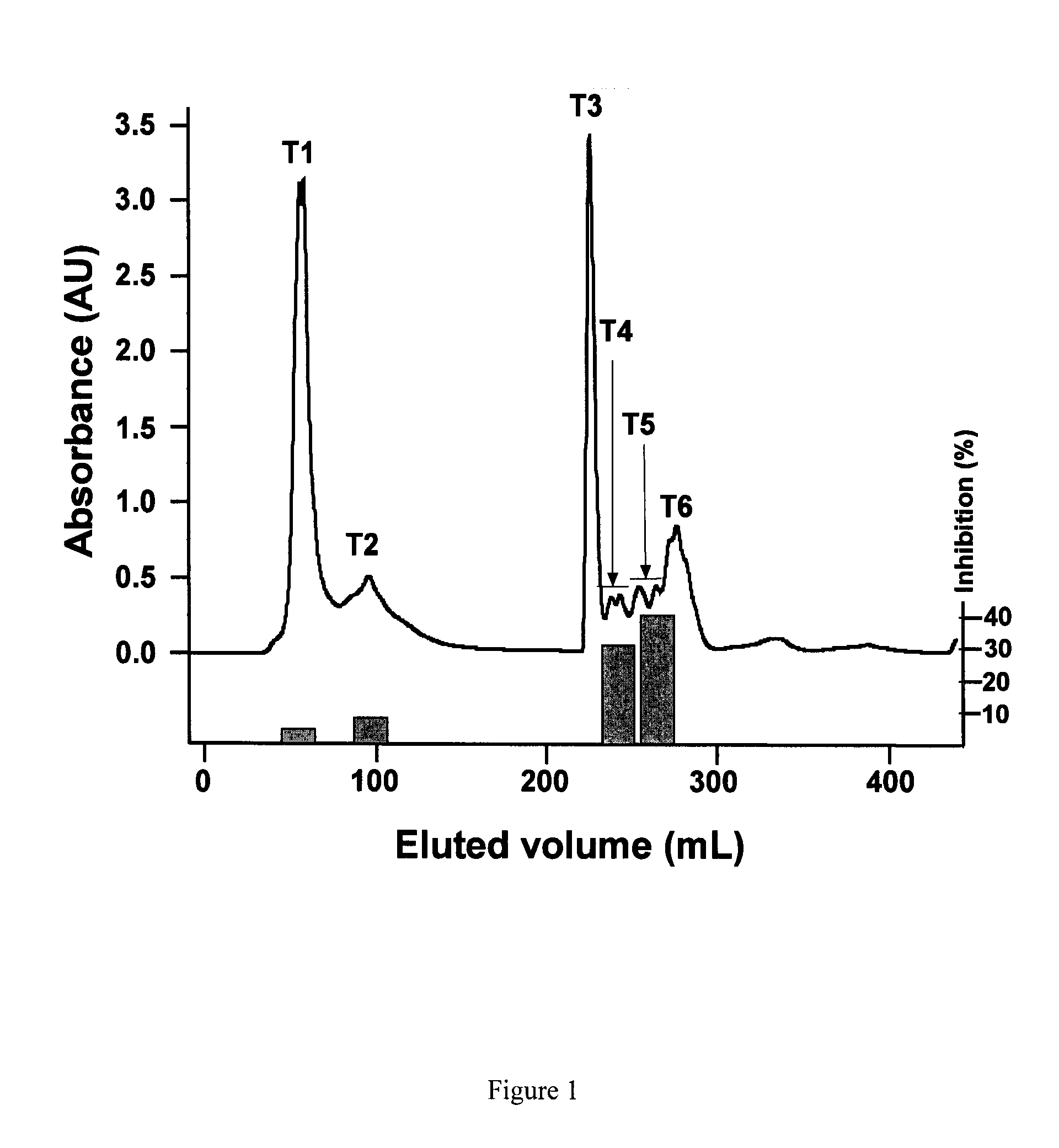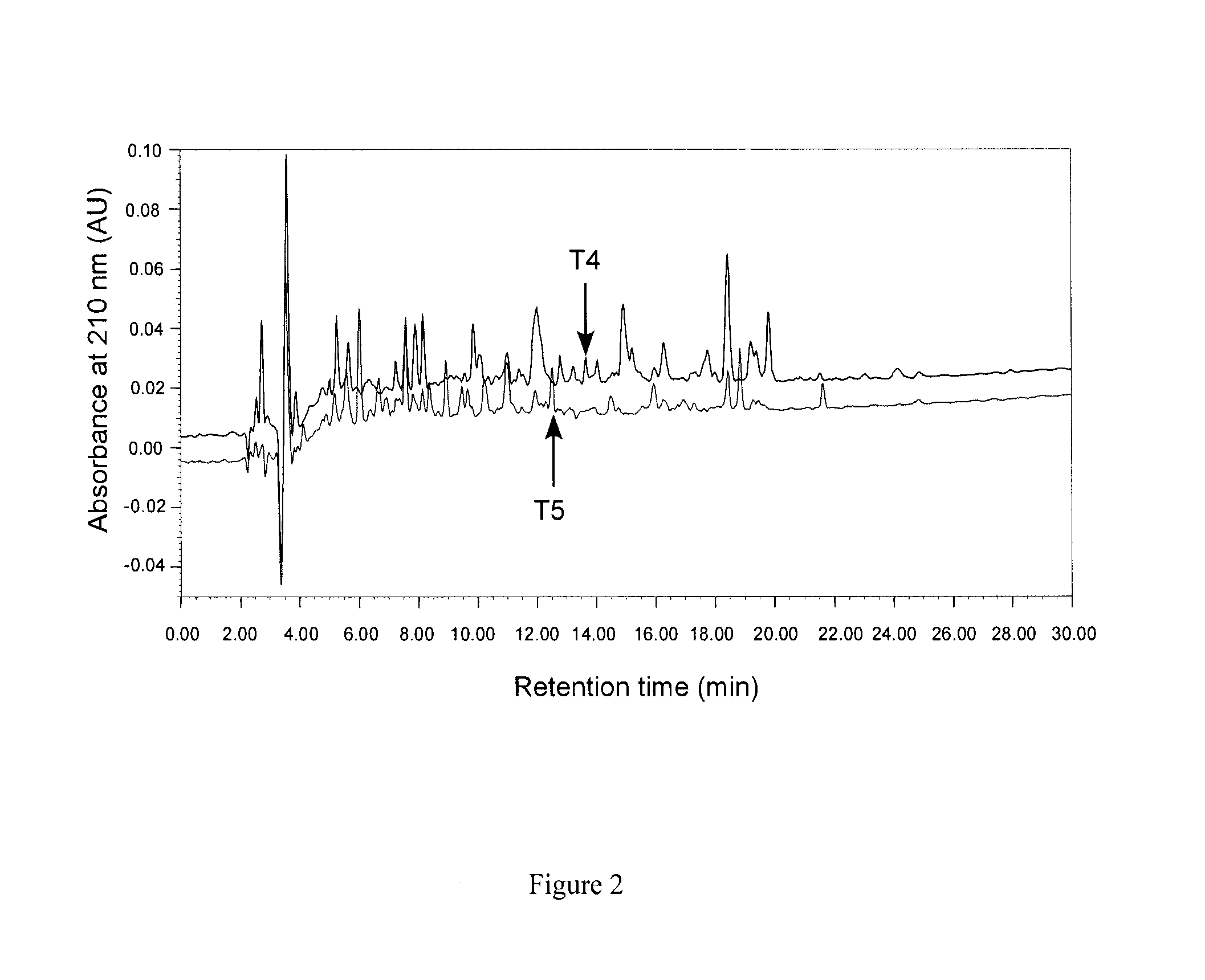Yellow pea seed protein-derived peptides
a protein-derived, yellow pea seed technology, applied in the field of yellow pea seed protein-derived peptides, can solve the problems of high research on renin inhibitors has been proved unsuccessful for clinical application, and the effect of arbs is a higher risk of myocardiac infarction
- Summary
- Abstract
- Description
- Claims
- Application Information
AI Technical Summary
Benefits of technology
Problems solved by technology
Method used
Image
Examples
example 1
Chemicals
[0082]Pea protein isolate (85% protein content) from Pisum sativum L. was a gift from Parrheim Foods (Portage La Prairie, Manitoba. Canada). Purified human recombinant renin was purchased from Cayman Chemical (13.29 U / mg, Ann Arbor, Mich., USA). The enzyme was supplied in 100 mM sodium acetate buffer, pH 4.2 with dry ice. Recombinant enzyme was expressed in HEK cells as the prorenin, and then was activated using trypsin and purified using peptide affinity chromatography. The purity is more than 99% estimated by SDS-PAGE, with a molecular weight of 40 kDa. Renin substrate 1 (Arg-Glu(EDANS)-Ile-His-Pro-Phe-His-Leu-Val-Ile-His-Thr-Lys(dabcyl)-Arg) was purchased from Molecular Probes, Inc. (Eugene, Oreg., USA). Purified rabbit lung angiotensin I-converting enzyme (ACE), thermolysin (Type X, Bacillus thermoproteolyticus rokko, 39 units / mg solid), hippuryl-histidyl-leucine (HHL), and hippuric acid (HA) were purchased from Sigma (St Louis, Mo.). HPLC-grade acetonitrile was purchas...
example 2
Hydrolyzed Pea Protein
[0083]Pea protein hydrolysate was prepared in a 800 mL reactor with temperature and pH control devices. Pea protein isolate (80% protein content) was dispersed in distilled water to obtain a 6.0% (w / v) protein slurry. After the slurry was heated to 55° C. and pH was adjusted to 8.0, thermolysin was then added to initiate the hydrolysis at a ratio of 0.5% (on the basis of protein weight, w / w). The temperature of the slurry was maintained at constant value for 3 h while pH 8.0 was maintained by addition of solid sodium hydroxide pellets when necessary. The hydrolysis was stopped by heating at 95° C. for 15 min. The hydrolysate was centrifuged at 10,000×g for 25 min. The clear supernatant was further passed through a cut-off molecular weight 3000 Da ultrafiltration membrane (Sartorius Co., Germany), the resulting permeate was collected, and freeze-dried for further use. Protein content of the hydrolysate was determined to be approx. 85%, while peptide yield was ap...
example 3
Separation and Identification of Active Fractions of Pea Protein Hydrolysate
[0084]Bioactive pea hydrolysate is produced by hydrolysis of pea protein isolate with food grade enzyme (thermolysin) followed by centrifugation to recover soluble peptides in the supernatant. The supernatant is passed through a 3 kDa ultra-filtration membrane and the permeate freeze-dried as the bioactive pea protein hydrolysate. The permeate is fractionated by preparative reverse-phase HPLC to yield renin-inhibitory fractions. The active fractions are separated by gel filtration followed by a second round of HPLC using reverse-phase column. HPLC elution is carried out with a linear gradient from solvent A (0.1% trifluoroacetic acid. TFA in water) to solvent B (0.1° / o TFA in acetonitrile) for 60 min at a flow rate that is optimized (at least 5 ml / min); absorbance is detected at 214 nm and pooled fractions collected. Solvents are removed from each pooled fraction in a rotary evaporator and the sample freeze-...
PUM
| Property | Measurement | Unit |
|---|---|---|
| pH | aaaaa | aaaaa |
| molecular weight | aaaaa | aaaaa |
| pH | aaaaa | aaaaa |
Abstract
Description
Claims
Application Information
 Login to View More
Login to View More - R&D
- Intellectual Property
- Life Sciences
- Materials
- Tech Scout
- Unparalleled Data Quality
- Higher Quality Content
- 60% Fewer Hallucinations
Browse by: Latest US Patents, China's latest patents, Technical Efficacy Thesaurus, Application Domain, Technology Topic, Popular Technical Reports.
© 2025 PatSnap. All rights reserved.Legal|Privacy policy|Modern Slavery Act Transparency Statement|Sitemap|About US| Contact US: help@patsnap.com



